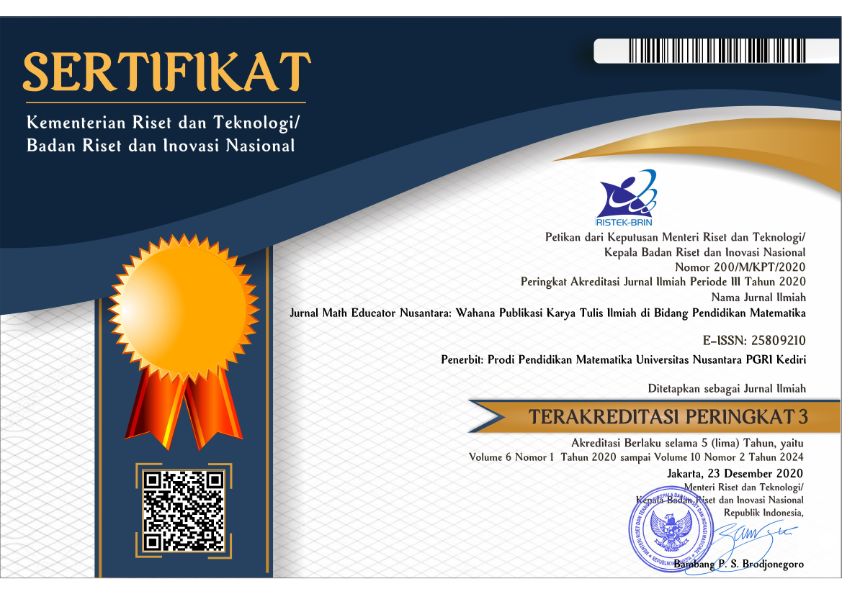Mathematical logical intelligence of students with high mathematical communication skills in system of linear equations in three variable
DOI:
https://doi.org/10.29407/jmen.v9i2.21491Keywords:
Mathematical Logical Intellegence, Mathematical Communications Skills, System of Linear Equations in Three VariableAbstract
Mathematical logical intelligence greatly influences students' ability to solve mathematical problems, especially the ability to analyze logically in solving mathematical problems. This logical-mathematical intelligence is also closely related and has a positive impact on students' mathematical communication skills, both oral and written mathematical communication abilities. Based on the age development, MA students should be able to use logical thinking skills well. Through material students are tested and required to understand questions in the form of story questions to be able to solve the problem by first forming a mathematical model and then developing a plan to solve the problem. Thus, students indirectly get a stimulus to hone their reasoning and communication skills well. This study aims to analyze the mathematical logical intelligence of MA students with high mathematical communication skills on System of Linear Equations in Three Variable at MA Al-Islamiyah I Sumber Batu, Blumbungan, Larangan, Pamekasan. This type of research is qualitative descriptive research. The research instruments used were test questions and interview guidelines. The results showed that students who have high mathematical logical intelligence also have good competence for oral and written communication and are able to classify, compare, perform calculations correctly, reason deductively, make conclusions and check back according to the indicators in mathematical logical intelligence.
References
Ab, J. S., Margono, G., & Rahayu, W. (2019). The Logical Thinking Ability: Mathematical Disposition and Self-Regulated Learning. Journal of Physics: Conference Series, 1155(1). https://doi.org/10.1088/1742-6596/1155/1/012092.
Aini, S. D., Zayyadi, M., & Saleh, K. A. (2020). Written mathematical communication skills on open-ended problems: is it different based on the level of mathematics ability?. MaPan: Jurnal matematika dan Pembelajaran, 8(2), 179-204. https://doi.org/10.24252/mapan.2020v8n2a2
Amy, C. (1996). Multiple Intelligences : Gardner ’ s Theory. Practical, Assessment, Research, and Evaluation, 5(10), 1–5.
Arum, D. P., Kusmayadi, T. A., & Pramudya, I. (2018). Students’ logical-mathematical intelligence profile. Journal of Physics: Conference Series, 1008(1). https://doi.org/10.1088/1742-6596/1008/1/012071 .
Azinar, J. A., Munzir, S., & Bahrun. (2020). Students’ logical-mathematical intelligence through the problem-solving approach. Journal of Physics: Conference Series, 1460(1). https://doi.org/10.1088/1742-6596/1460/1/012024 .
Derakhshan, A., & Faribi, M. (2015). Multiple Intelligences: Language Learning and Teaching. International Journal of English Linguistics, 5(4). https://doi.org/10.5539/ijel.v5n4p63 .
Hakim, L. L., & Yanuarsari, R. (2017). Use of Educative Teaching Aids in Improving Logical-Mathematical Intelligence for Early Childhood. Ahmad Dahlan International Conference on Mathematics and Mathematics Education, October 2017, 13–14. http://seminar.uad.ac.id/index.php/adintercomme/article/view/27
Helwig, N. E., Hong, S., Hsiao-Wecksler, E. T., & Polk, J. D. (2011). Methods to temporally align gait cycle data. Journal of biomechanics, 44(3), 561-566. Doi: https://doi.org/10.1016/j.jbiomech.2010.09.015
Lanya, H., Zayyadi, M., Aini, S. D., & Haris. (2020). Mathematic Communication Skills in Senior High School Based on Gender Differences. Pi: Mathematics Education Journal, 3(2), 15–21. https://doi.org/10.21067/pmej.v3i2.4718
NCTM. (2000). Principles and standards for school mathematics. http://www.nctm.org/standards/content.aspx?id=16909
Nisa, F. B., Mukhlis, M., & Maswar, M. (2020). Analisis Hubungan Antara Kecerdasan Logis Matematis Dengan Kemampuan Komunikasi Matematis Siswa. Alifmatika: Jurnal Pendidikan Dan Pembelajaran Matematika, 2(2), 199–211. https://doi.org/10.35316/alifmatika.2020.v2i2.199-211
Setiyani, Putri, D. P., Ferdianto, F., & Fauji, S. H. (2020). Designing a digital teaching module based on mathematical communication in relation and function. Journal on Mathematics Education, 11(2), 223–236. https://doi.org/10.22342/jme.11.2.7320.223-236
Siniguian, M. T. (2017). Students’ difficulties in solving mathematical problems. International Journal of Advanced Research in Engineering and Applied Sciences, 6(2), 1–12. https://doi.org/10.1063/5.0120257
Suwarno, S., Nisa, F. B., & Mukhlis, M. (2020). Does students’ logical-mathematical intelligence correlate to mathematics communication skills on a linear system with three variables problems? Journal of Physics: Conference Series, 1663(1). https://doi.org/10.1088/1742-6596/1663/1/012029
Ulfah, A. S., Yerizon, Y., & Arnawa, I. M. (2020). Preliminary Research of Mathematics Learning Device Development Based on Realistic Mathematics Education (RME). Journal of Physics: Conference Series, 1554(1). https://doi.org/10.1088/1742-6596/1554/1/012027
Yayuk, E., Purwanto, As’Ari, A. R., & Subanji. (2020). Primary school students’ creative thinking skills in mathematics problem solving. European Journal of Educational Research, 9(3), 1281–1295. https://doi.org/10.12973/eu-jer.9.3.1281.
Zayyadi, M., & Kurniati, D. (2018). Mathematics reasoning and proving of students in generalizing the pattern. International Journal of Engineering & Technology, 7(2), 15-17.
Zayyadi, M., Nusantara, T., Subanji, S., Hidayanto, E., & Sulandra, I. M. (2019). A commognitive framework: The process of solving mathematical problems of middle school students. International Journal of Learning, Teaching and Educational Research, 18(2), 89-102. Doi: https://doi.org/10.26803/ijlter.18.2.7
Zayyadi, M & Pratiwi, E. (2022). Berpikir Dan Komunikasi Dalam Kerangka Commognitive. Bandar Publishing.
Downloads
Published
Issue
Section
License
Authors who publish with this journal agree to the following terms:
- Copyright on any article is retained by the author(s).
- The author grants the journal, the right of first publication with the work simultaneously licensed under a Creative Commons Attribution License that allows others to share the work with an acknowledgment of the work’s authorship and initial publication in this journal.
- Authors are able to enter into separate, additional contractual arrangements for the non-exclusive distribution of the journal’s published version of the work (e.g., post it to an institutional repository or publish it in a book), with an acknowledgment of its initial publication in this journal.
- Authors are permitted and encouraged to post their work online (e.g., in institutional repositories or on their website) prior to and during the submission process, as it can lead to productive exchanges, as well as earlier and greater citation of published work.
- The article and any associated published material is distributed under the Creative Commons Attribution-ShareAlike 4.0 International License















